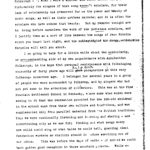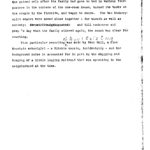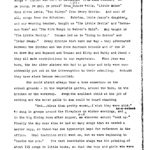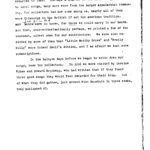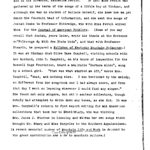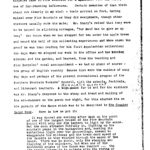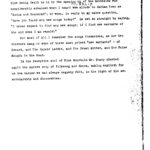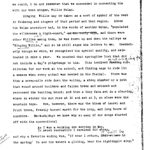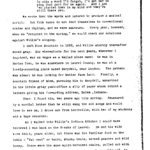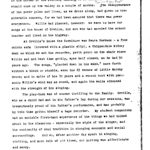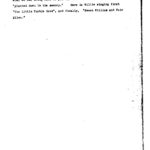Pine Mountain Settlement School
Series 02: GOVERNANCE
Series 09: BIOGRAPHY – Staff
Evelyn K. Wells
Harvard University Address
1955
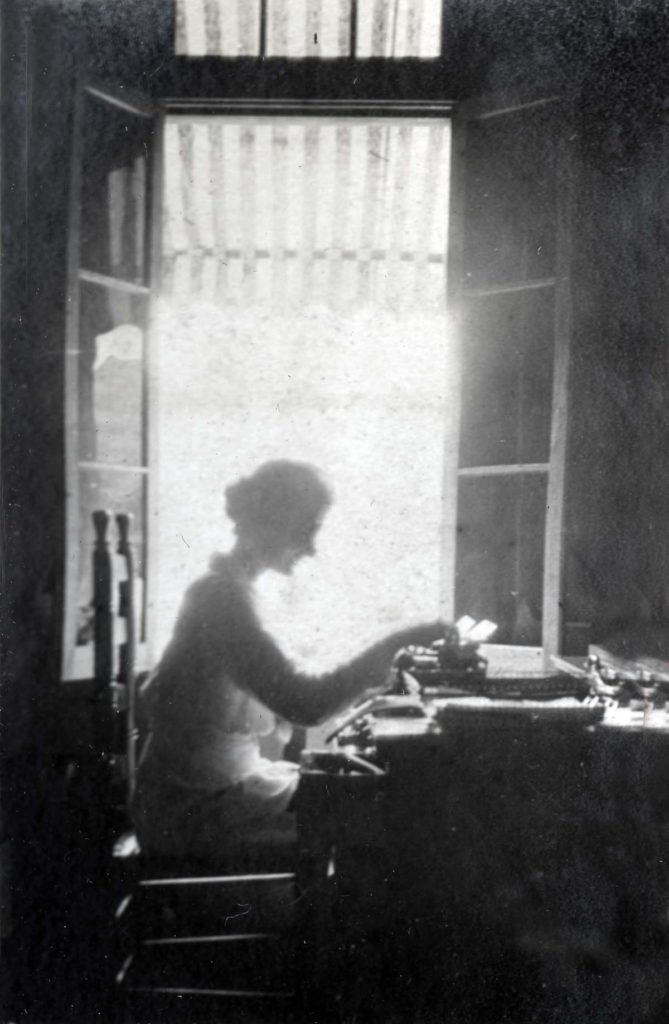
Angela Melville Album II – Part VI. “E.K.W.” (Evelyn K. Wells) [melv_II_album_282x.jpg]
TAGS: Evelyn K. Wells, folksongs, Marguerite Butler, PMSS early history, Harvard University address, Appalachian Folksongs, PMSS community singers and players
EVELYN K. WELLS Harvard University Address 1955
July 21,1955, Harvard University
Appalachian Folksongs
Evelyn K. Wells was a secretary and fundraiser at Pine Mountain Settlement School and, in later years, a member of the Board of Trustees. Her official years of association with the School were approximately 1916-1931. She briefly served as acting director in 1931, following the departure of Katherine Pettit and the hiring of new Director, Glyn Morris in 1932.
The following copy is an annotated copy of an address by Wells held by Pine Mountain Settlement School Collections.
CONTENTS: Evelyn K. Wells ; Pine Mountain Settlement School ; folksongs ; folklore ; transcriptions ; letters ; Marguerite Butler ; Board of Trustees ; PMSS early history ; Jean Ritchie ; Maud Karples ; Mary Ann Begley ; Harlan Town ; Abner Boggs ; Aunt Leah Smith ; Fiddler John Lewis ; Aunt Betts Scott ; Uncle William Creech ; Aunt Sal Creech ; hickory-split chairs ; Fern Hall Hayes ; Sabrina Ritchie ; Jason Ritchie ; Truman Ritchie ; Kitty Ritchie ; May Ritchie ; Pattie Ritchie ; Raymond Ritchie ; Jewell Ritchie ; Loraine Wyman ; Howard Brockway ; Cecil Sharp ; Olive Dame Campbell ; Josiah Combs ; Hubert Gibson Shearin ; George Lyman Kittredge ; Willie Nolan ; Orville Nolan ; Turner family ; Mrs. James J. Storrow ;
TRANSCRIPTION: EVELYN K. WELLS Harvard University Address 1955
“July 21, 1955, Address by Evelyn K. Wells at Harvard University.”
[APPALACHIAN FOLKSONGS] [Annotated copy of address held by PMSS]
There is a lovely line that wanders in and out of many folksongs — “I wish I were a scholar and could handle the pen…” Fortunately, the singers of that song weren’t scholars, for their lack of scholarship has preserved for us the power and beauty of their songs, as well as their artless naivete; and it is often the scholars who have undone that beauty. But my remarks tonight are to bring before ourselves the work of the judicious scholars, and I justify them as a sort of link between the songs of Jean Ritchie which you heard last night, and the collecting of the songs which Miss Karpeles [Maud Karpeles] will tell you about.
I am going to talk for a little while about the unscholarly, or pre-penhandling side of my own acquaintance with Appalachian Folksongs, in the hope that personal reminiscence of a folksinging community of forty years ago will help our perspective in this very folksong-conscious age. I belonged for several years in a group of people who were surrounded by folksong, and by singers who had not yet come to the attention of collectors. This was at the Pine Mountain Settlement School in Kentucky, where some wise women were seeing to it that the recreation provided for the 100-odd children in the school came from their own culture and traditions, and was supplemented only from a parallel material from the British tradition. Thus we were continually learning and sharing — and contributing only as we saw fit; finding out what songs every new child could sing or what tales he could tell, guarding lest fotched-on workers or visitors should induce something out of our idiom. This was before the days of radio — if indeed we could have gotten good reception in those mountain pockets. While we heard plenty of popular songs as well as folksongs, we had never heard of “hill-billy.” And few of the songs we exchanged had been written down.
We were, fortunately, far from towns or settlements, and could do as we pleased without suffering from the prejudices that had turned solid citizens elsewhere against dancing and devil’s ditties. Behind the wall of Pine Mountain, with Harlan Town a good 18 miles away, we drew our school family from the creeks that wove their way through the Kentucky Ridges, with not a railroad and hardly a good wagon road for many miles to the north. From our own neighborhood came Mary Ann Begley, who sang “The NIghtingale” and “Lord Bateman” over our washtubs; Abner Boggs who every Fair Day [Community Fair Days Guide] sent his great voice out against the hillsides as he sang “Lolly Toodum” and “Judah Land” for the crowd;
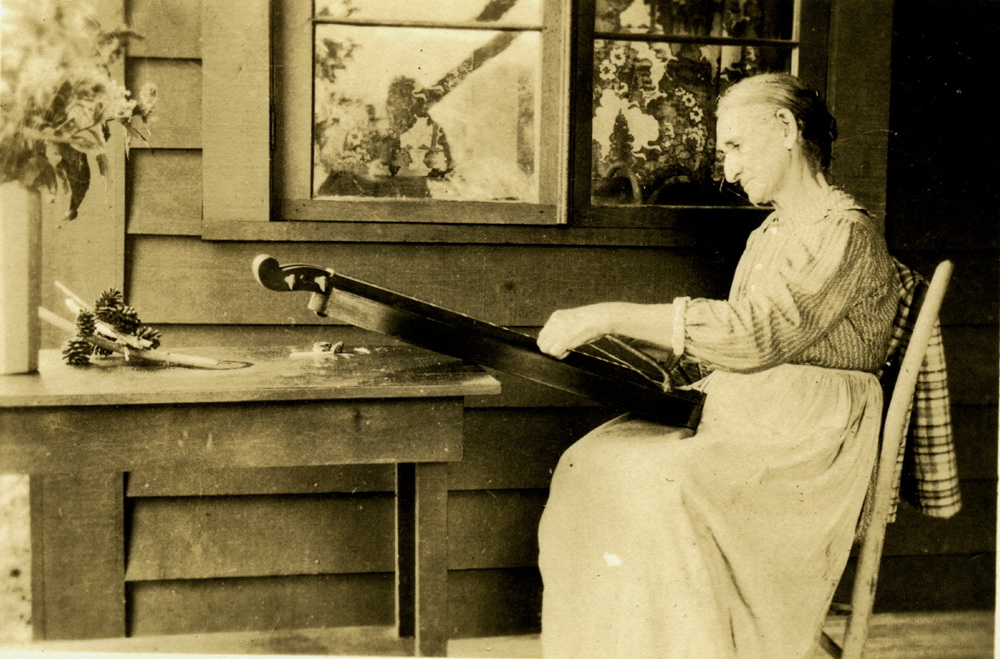
Aunt Leah playing dulcimer with a bow. [hook_album_2blk__020.jpg]
Aunt Leah Smith who taught us to bow the dulcimer, Fiddler John Lewis, dropping in with a consignment of axe-handles and plenty of time to sit and talk about his art:
I always play a tune the way she sounds, and not the way she’s wrote; then you can raise her up higher if she’s too low, or you can drap her down lower if she’s too high, or if she haint much good, you can dress her up as you go along… Now I’ll play you “Napoleon Crossing the Rockies.”
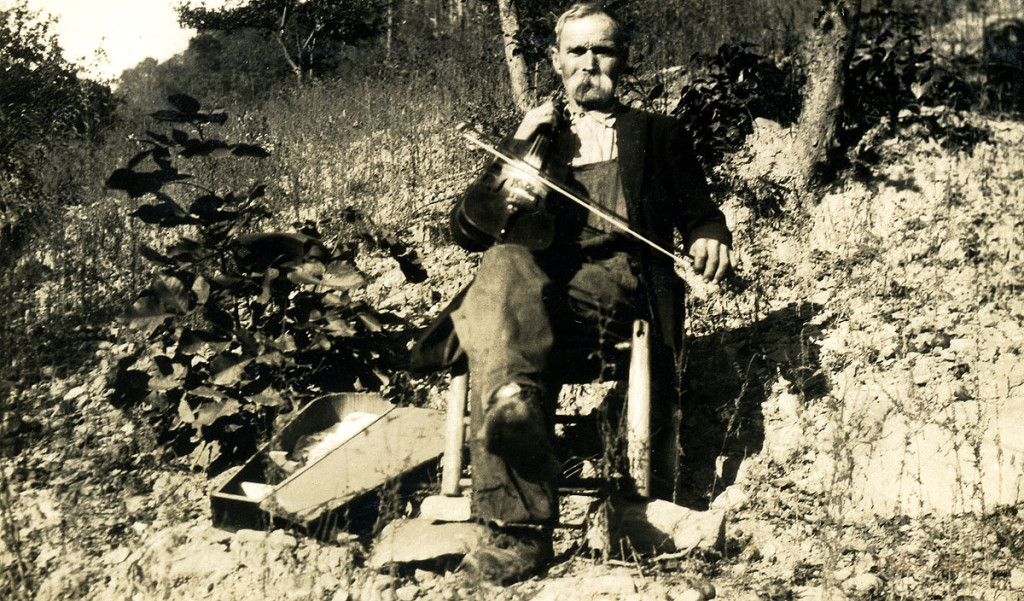
“‘Fiddler’ John” with his donated violin. [kingman_017c]
On Saturday nights the Turner boys [See: Turner Family] from Big Laurel, came in with other boys and girls from the neighborhood to call for sets [set-running of the Kentucky Running Set] and play-party games. Whenever the floor of the new building was laid (we were in the construction stage then), we celebrated by running sets with the workmen, on that new floor. Aunt Sal, [Sally Dixon Creech] wife of our founder, William Creech, came by almost daily, a grand old woman with her kerchief, corn-cob pipe and walking stick. There was no one of us who hadn’t sat by her fireside and heard her sing her priceless satire on the tongue-tied suitor, a song unique as far as I know, and I could well believe she composed it herself, it is so full of her own pithy and kindly humor.
I might explain that in the old-fashioned mountain home privacy for young people who were “Talking” — or courting — was gained only after the family had gone to bed in various four-posters in the corners of the one-room house,
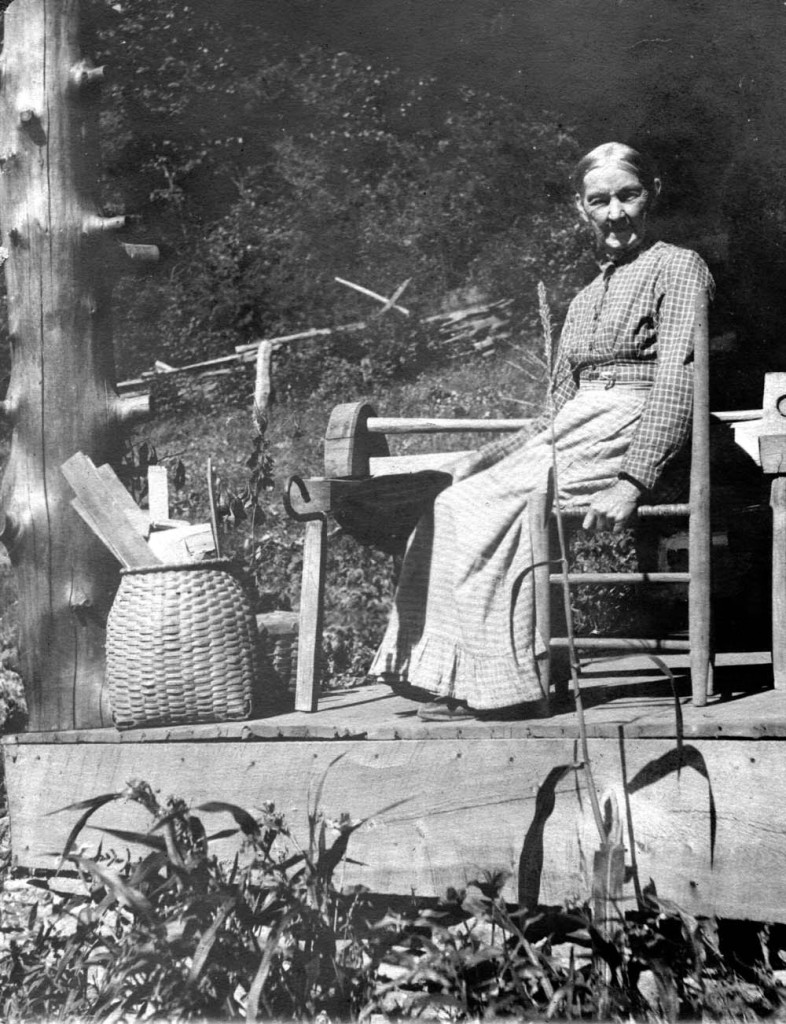
Aunt Betts Scott [Sister of Aunt Sal Creech] seated on porch at Old Log in a hickory-split chair with hickory basket at her feet and flax beater behind her. Vl_37_1186a.jpg
turned its backs on the couple by the fireside, and begun to snore. The two hickory-split chairs were moved close together — for warmth as well as society; and till cock-crow and peep ‘o day when the family stirred again, the coast was clear for courting.
This particular recording of Aunt Sal’s Song was made by Fern Hall [Hayes], a Pine Mountain schoolgirl — a Ritchie cousin, incidentally [first cousin]— and the background noise is accounted for in part by the chugging and bumping of a little logging railroad that was operating in the neighborhood at the time.* [Not entirely accurate, as the logging railroad had been pulled up from the center of campus when Fern Hall was recorded by Alan Lomax in 1937. The earliest it could have been recorded was 1933 when Fern first came to Pine Mountain as a student. Aunt Sal Creech [Sally Dixon Creech] died in 1925.]
But it was from the children that we learned most of our songs — “Christ was Born in Bethlehem,” from Edna Feltner, “Oh Ye Young, Ye Gay, Ye Proud,” from little Ninnie Wells, “Little Mohee,” from Elvie Lewis, “Tom Boleyn,” from Henry Harris. And most all, songs from the Ritchies. Sabrina [Sabrina Ritchie], Uncle Jason‘s daughter [Jason Ritchie, was first cousin to Jean Ritchie’s father] and our weaving teacher, taught us “The LIttle Devils,” and “Nottamun [sic] Town,” and “The Wife Wrapt in Wether’s Skin.” May [Ritchie Deschamps] taught us “The Little Family.” Truman [Ritchie] led us in “Going to Boston,” and “Cedar Swamp.” Every Ritchie that came our way — they alternated between the Hindman and the Pine Mountain Schools and of the 14 [children] we drew May and Raymond and Truman and Kitty and Patty and Jewel — they all made contributions to our repertoire. When Jean was born, the two older sisters who had to go home and help were considerably put out at the interruption to their schooling. No doubt they have since become reconciled. [See: Ritchie, Jean. Singing Family of the Cumberlands, 1955, for more details on the Ritchie family.]
One could almost always hear a tune somewhere on the school grounds — in the vegetable garden, around the barn, in the kitchen or the workshop. Even the smallest child at his job of setting out the water pails to sun could be heard chanting. “God … bless them pretty women, I wish they were mine,” We sang in groups around the fireplace on winter evenings, and in the big dining room after supper, and whenever school “took up.” Finally the day came when we had so many songs that we needed a master copy, so there was one typescript kept for reference in the office. Oral tradition still went on, but we were beginning to “handle the pen.”
The next inevitable stage was the printing of about 115 songs in little books, so that the boys and girls who were now coming more from the radio-bitten mining towns than from the country farms might have their disappearing inheritance returned to them. Perhaps a quarter of the book [The Pine Mountain Song Book and Other Ballads, 1923] was given over to local songs, many more were from the larger Appalachian community, for collectors had now come among us, nearly all of them were folksongs in the British if not the American tradition. We printed no tunes, for those we could carry in our heads. And then, over-enthusiastically perhaps, we printed a few of the choicest, oldest ones for our contributors. We were soon reminded by soe of them that “Little Matthy Grove,” and “Pretty Polly,” were indeed devil’s ditties, and I am afraid we lost some subscriptions.
In the halcyon days before we began to write down our songs, came the collectors. In 1916 we were visited by Loraine Wyman [Folklorist and singer] and Howard Brockway [American composer] who had written that if they found three good songs they would feel reward for their trip. Out of what they did gather, just around Pine Mountain in three weeks, they published 45.
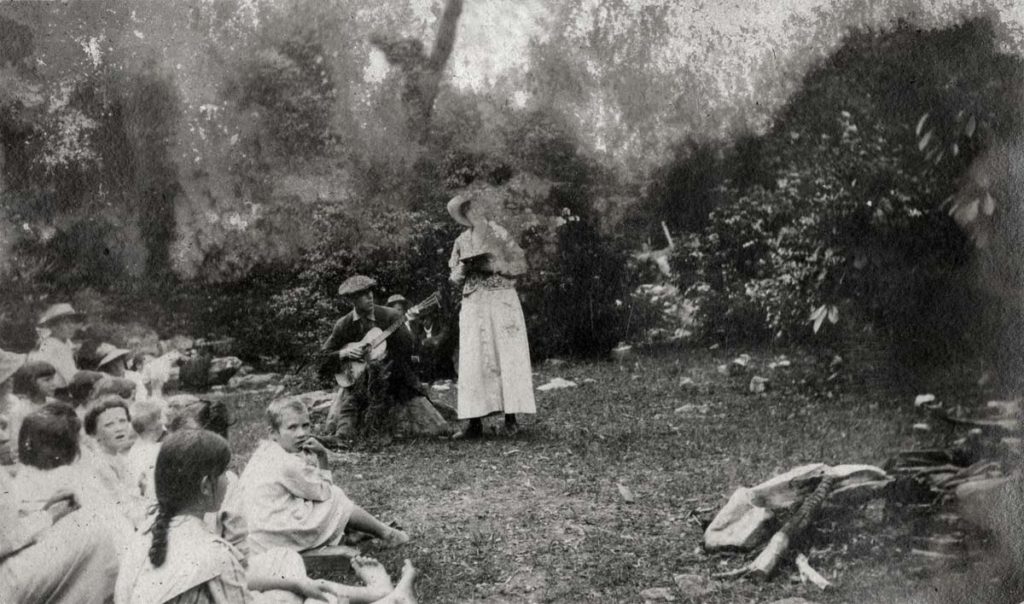
Howard Brockway and Loraine Wyman, 1916. [Restored version.] Angela Melville Album II – Part IV. .[melv_II_album_158x.jpg]
At this point I must go back to the parent school, Hindman and to its director [co-director], Katherine Pettit. In 1907 Miss Pettit had gathered up the texts of the songs of a little boy at Hindman, and although she was no student of ballads herself, she knew how to get reach the fountainhead of information, and she sent the songs of Josiah Combs [1886-1960] to Professor Kittredge, [George Lyman Kittredge February 28, 1860 – July 23, 1941] who with Miss Pettit edited them for the Journal of American Folklore. (Some of you may recall that Josiah, years later, wrote his thesis at the Sorbonne on “Folksongs du Midi des Etats Unis,” and that, with Professor Shearin, [Hubert Gibson Shearin co-author with Combs of Syllabus of Kentucky Mountain Folksongs prior to 1923]. It was at Hindman that Olive Dame Campbell, visiting schools with her husband, John C. Campbell, on his tours of inspection for the Russell Sage Foundation, heard a memorable “Barbara Allen,” sung by a school girl. “That started me off,” wrote Mrs. Campbell, “that, and nothing else. I was bewitched by the melody so different from the song-book one I had always known, and from that day I went on learning wherever I could find any singer.” She found not only singers, but other amateur collectors, though nobody had attempted to write down any tunes as she did. It was Mrs. Campbell’s concern to find expert editing for all these collections that took her to Cecil Sharp, who was visiting Mrs. James J. Storrow in Lincoln; and it was her own songs which brought Mr. Sharp and Miss Karpeles [Maud Karpeles] to the Southern Appalachians. (A recent memorial number of Mountain Life and Work [April 1925] is devoted to the great contributions Mrs. Campbell made to mountain culture.)
And so, on a hot August day in 1917, Cecil Sharp and Maud Karpeles [visit to Pine Mountian Settlement School] came to Pine Mountain for a five-day visit, one of far-reaching influences. Certain memories of that visit stand out clearly in my mind: — their arrival on foot, having walked over Pine Mountain as they did everywhere, though other visitors usually rode the mule; Mr. Sharp’s relief that they were to be housed in adjoining cottages, “for Maud had to give me my tea;” the hours when we too stopped for tea under the apples trees and heard him tell of his collecting experiences and were shown the proof he was then reading for his first Appalachian collection; the days when we stopped our work in the office and the canning kitchen and the garden, and learned, from his teaching and Miss Karpeles’ vocal accompaniment — we had o piano of course — the group of English country dances that were the nucleus of many May Days and perhaps of the present recreational program of the Southern Mountain Workers’ Council, with its schools, festivals, and itinerant teachers. A dramatic moment for us and for the visitors was Mr. Sharp’s response to the stamp and tread and calling of the suet-runners on the porch one night, for this started him on his pursuit of the dance which was to be described in [Cecil Sharp’s] The Country Dance Book, [1909]. Here is how he put it:
It was danced one evening after dark on the porch of one of the largest houses of the Pine Mountain School with only one dim lantern to light up the scene,. But the moon streamed fitfully in, lighting up the mountain peaks in the background and, casting its mysterious light over the proceedings, seemed to exaggerate the wildness and the break-neck speed of the dancers as they whirled through the mazes of the dance. There was no music, only the stamping and clapping of the onlookers, but when one of the emotional crises of the dance was reached ,,, the air seemed literally to pulsate with the rhythm of the ‘patters’ and the tramp of the dancers’ feet, while over and above it all, penetrating through the din, floated the even, falsetto tones of the Caller, calmly and unexcitedly reciting his directions.
My own education in the values of oral tradition and the blow being dealt to it by the opening up of the mountains was considerably advanced when I heard Mr. Sharp allude to Harlan Town as “Sodom and Gomorrah”; or when, in reply to my naive question, “Have you found any new songs today?” he set me straight by saying, “I never expect to find any new songs; if I find new variants of the old ones I am repaid.”
But most of all I remember the songs themselves as our two visitors sang us some of their most prized “new variants” — of “Edward” and the “Gypsie Laddie,” and “The Cruel Mother,” and “The False Knight in the Road.”
In the receptive soil of Pine Mountain, Mr. Sharp planted again the native crop of folksong and dance, making explicit for us the values we had always vaguely felt, in the light of his own scholarship and discoveries.
But although we put him in the way of as many singers as we could, I do not remember that we succeeded in connecting him with our best singer, Willie Nolan.
Singing Willie may be taken as a sort of symbol of the best in folksong and singers of that period and that region. Since his Nolan ancestors had, in the words of another Nolan, “populated the wilderness a right-smart,” and there were other Willies now among them, he was known up and down the valleys as “Singing Willie,” and so he still signs his letters to me. Un-scholarly though we were, we recognized his special quality and celebrated it once a year. We counted that springtime lost that did not include a day’s pilgrimage to him. This involved our arranging for substitutes for our work at the school, and finding nags to ride (in a season when every animal was needed in the fields). There was then a seven-mile ride down the valley, a steep clamber up a path that wound around boulders and fallen trees and crossed and recrossed the tumbling brook; and then a tiny farm set in a clearing, where in winter the sun rose at 10 and set at 3, so close were the mountain tops. Now, however, there was the bloom of laurel and fruit trees, freshly turned earth for the crop, and long hours of sunshine. On such days we knew why so many of our songs started off with the conventional
As I was walking one morning in May,
In sweet recreation I careless did stray,
and why a favorite ending was,
“If ever I return, it will be in the spring
To see the waters a gliding,
hear the nightingale sing.”
Willie never knew when the school women were coming for he never went for his mail. But we could count on finding him at home at planting time. I mention this because it was the more remarkable that he should stop such vital work and spend hours singing to us. The children would slip into the room, sitting quietly, his wife move in and out about her work. And Willie, half closing his eyes, tipping his head back, one foot and one hand just indicating his steady pace, would go into what Randall Thompson has described as an “atavistic trance”, retiring into the song with mask-like dignity, and his resonant tones seemed almost to push out the walls of the little room. He sang of “Sweet William and Fair Ellen,” a story that must have come to Scotland with the Danes; of “Lady Barnard and Little Musgrave,” whose Tristan-and-Iseult affair was on the Elizabethan hit parade in Beaumont and Fletcher’s “Knight of the Burning Pestle,” [A play in five acts by Francis Beaumont, first performed in 1607 and first published in a quarto in 1613. It is the first whole parody (or pastiche) play in English. The play is a satire on chivalric romances … Wikipedia ], and of “The Little Turtle Dove,” the inspiration for Burns’s “My love is like a red, red rose.” But Singing Willie’s repertoire was not entirely out of Child[‘s] ballads. [A reference to Child Ballads a collection of some 305 traditional ballads from England and Scotland, and their American variants, anthologized by Francis James Child during the second half of the 19th century. Wikipedia] He had made up a delightfully broad and gossipy song about all his neighbors, with which he used to regale them when they were working out their road tax and sat down to rest. He had a store of graveyard poetry which he could recite in the best sentimental tradition, And some good folksongs like “The Old Woman Who Lived Near London,” he would announce as “sung and wrote by Willie Nolan.” Mostly, however, he gave credit to his mother:
I learnt her songs when I was from 6 to 8 year old. I can sing those old songs that she used to sing, when I was little standing around her knees, and it brings her back, and I can picture her standing before me singing; I can almost hear her voice … She was a great singer, she could just sing all day or all night … I was the only one in the family that paid any attention to it; I was learning them all the time. I’d get off in the woods by myself and I’d start one, and I’d go right on through, and if I happened to miss a word I’d forgot, I’d get her to sing that part for me again, And I got ’em planted down in my mind and they’re still there yet.
We wrote down the words and labored to produce a musical script. But folk tunes do not lend themselves to conventional scales and rhythms, and we were amateurs. Every year, however, when we “returned in the spring,” we would check our notations against Willie’s singing.
I left Pine Mountain in 1928, and Willie shortly thereafter moved away. His whereabouts for the next years, whenever I inquired, was as vague as a ballad place name: he was at a lovely-sounding place named Marydell, near London [KY]. The pattern was clear; he was looking for better farmland. Finally, a mountain friend of mine, pursuing him to Marydell, unearthed in the little grimy post-office a slip of paper stuck behind a lantern giving his forwarding address, Salem, Indiana.
There I found him, two years ago this spring. Reassured by a cordial letter that he still sang the old songs and would love to see me, I drove out from Louisville, with two of my students and a tape recorder.
As I walked into Willie’s Indiana kitchen I could have believed I was back on the Breaks of Laurel. He and his wife were thirty years older, but there was the familiar food on the table — “fat meat” or bacon, shucky beans, canned peaches, and wild honey. There were the same split -bottomed chairs, pulled out with the same welcome, “Pull ye up a chair and eat dinner with us,” in the most matter-of-fact way, as if I were still a neighbor.
Outside, the hills rose as steeply as in Harlan County, but they surrounded a broader bottom land. And the new washing machine was in the corner of the kitchen, waiting to be connected when the power should come up the valley in a couple of months. I can say that the disappearance of the power poles and lines, as we drove along, had given us considerable concern, for we had been assured that there was power everywhere. Willie had planned, however: we were to have our songs at the house of Orville [Orville Nelson], his son who had married the school teacher and lived on the highway.
At Orville’s house the furniture was Sears Roebuck — a fine chintz sofa (covered with a plastic slip), a Chippendale kidney desk on which we set the recorder, petit point on the chair where Willie sat and beat time gently, eyes half-closed, as he had 30 years ago. The songs, “planted down in his min,” came forth without a hitch or stumble, even the 23 versed of “Little Matthy Grove“: and in spite of his 70 years and a recent bout with pneumonia Willie’s wind was as sound, and again the walls vibrated with the strength of his singing.
The playback was, of course, thrilling to the family. Orville who as a child had sat in his father’s lap during our sessions was tremendously proud of his father’s performance and has probably by this time gotten himself a tape recorder. My student companions had an enviable first-hand experience of the things we had talked about in the classroom — especially the style of the singer, and the continuity of oral tradition in changing economic and social surrounding. And so, after another day spent in singing, visiting, and much talk of old times, our parting was affectionate and merry.
Singing Wilie Revisited continues to be a symbol of folksong today, when we can bring back to you the voice itself, singing the songs “planted down in the memory.” Here is Willie singing first: “The Little Turtle Dove”, and finally, “Sweet William and Fair Ellen.”
[RECORDING NOT AVAILABLE – Visit Berea Sound Archives to listen to additional renditions.]
GALLERY: EVELYN K. WELLS Harvard University Address 1955
- [well_har_003]
- [well_har_004]
- [well_har_005]
- [well_har_006]
- [well_har_007]
- [well_har_008]
- [well_har_009]
- [well_har_010]
- [well_har_011]
- [well_har_012]
- [well_har_013]
- [well_har_014]
- [well_har_015]
EVELYN K. WELLS PUBLICATIONS
The Ballad Tree: A Study of British and American Ballads, Their Folklore, Verse and Music, Together with Sixty Traditional Ballads and Their Tunes. New York: Ronald Press, 1950. Print.
[See below for a listing of additional publications.]
EVELYN K. WELLS A Little True Blue American, Over Sea and Land: Our Southern Mountains, November 1920, p. 140.
EVELYN K. WELLS TALKS
EVELYN K. WELLS Harvard University Address, July 21, 1955
BIBLIOGRAPHY
Combs, Josiah. Josiah Henry Comb Papers. Berea College, KY. Hutchins Library http://community.berea.edu/hutchinslibrary/specialcollections/saa71.asp
Combs, Josiah. Josiah H. Combs, Folk–Songs of the Southern United States, ed. D. K. Wilgus (1925) See also: Shearin, Hubert Gibson
Brockaway, Howard. https://en.wikipedia.org/wiki/Howard_Brockway
Wyman, Loraine. See: Wikipedia: Loraine Wyman (October 23, c. 1885 – September 11, 1937) was an American folksinger, mountain dulcimer player, and music collector. In 1916, she and her accompanist, Howard Brockway, traveled for six weeks in the Cumberland Mountains collecting folk songs.[1] They published these in two collections: Lonesome Tunes: Folk Songs from the Kentucky Mountains (1916, New York); Twenty Kentucky Mountain Songs (1920, Boston). Wyman also collected songs in Percé, Quebec, which she documented in an article in the Journal of American Folklore.[1]
SEE ALSO
EVELYN K. WELLS Guide to Excerpts From letters Home 1915-1923
CECIL SHARP AND MAUDE KARPELES Visit to PMSS
JAMES GREENE Account of Cecil Sharp and Maude Karpeles at PMSS
PETER ROGERS Account of Cecil Sharp and Maude Karpeles Visit to PMSS

